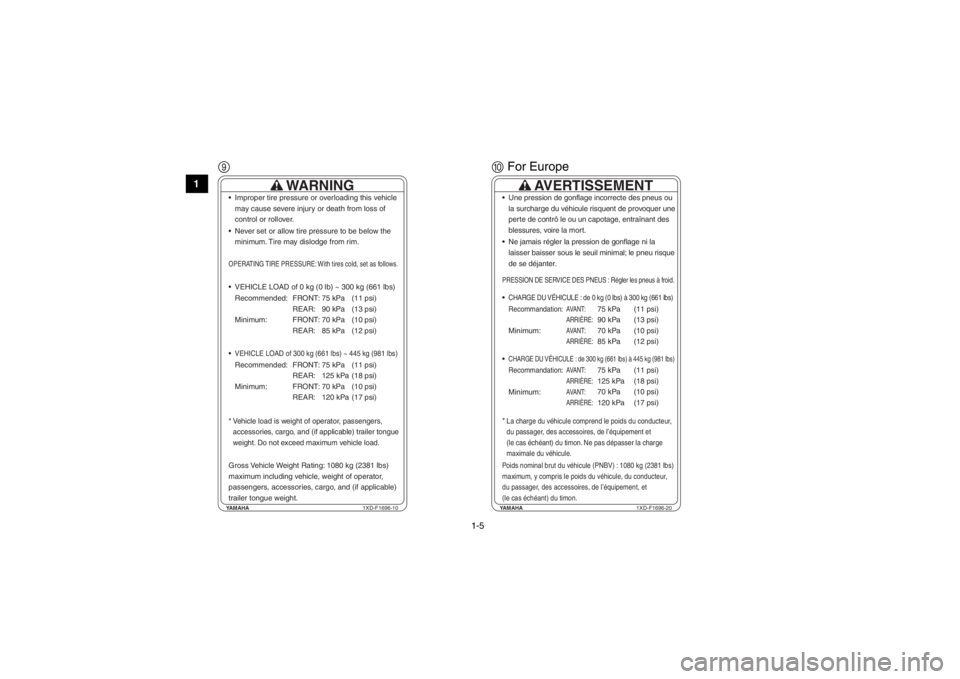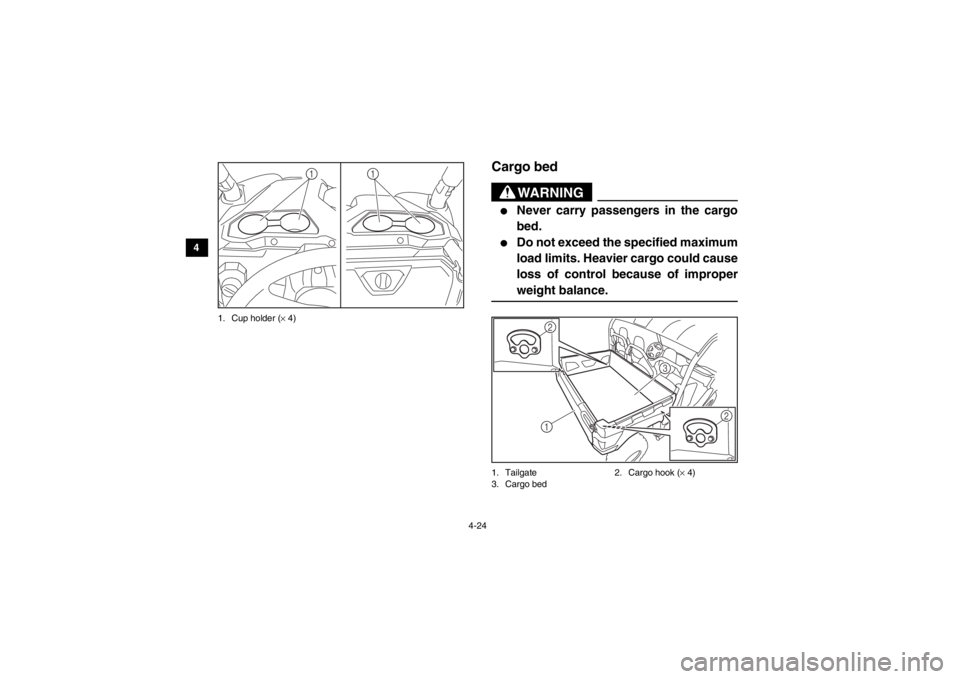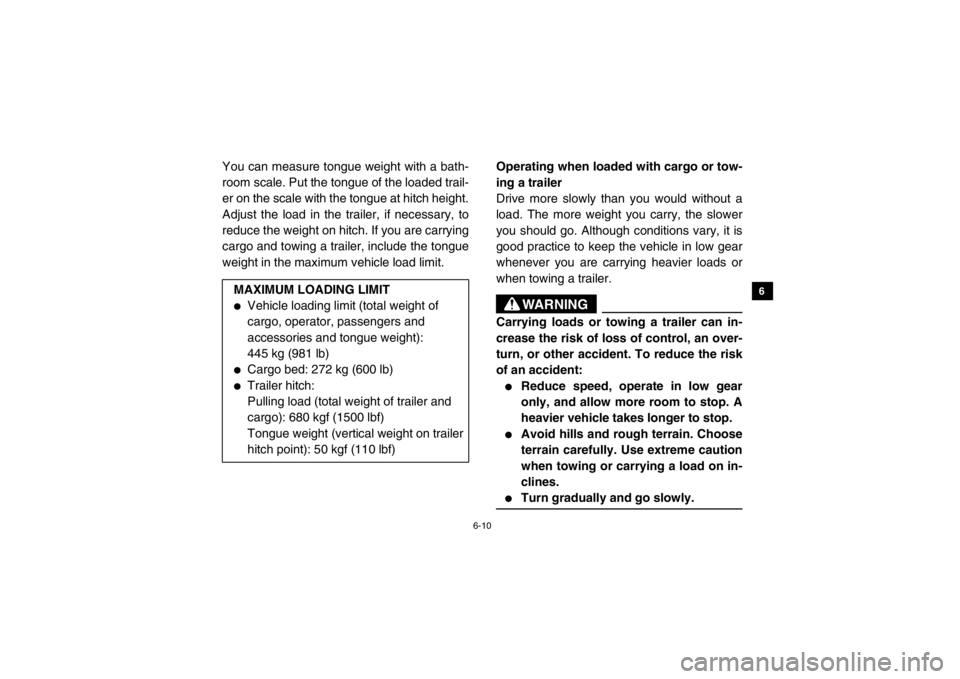2014 YAMAHA VIKING weight
[x] Cancel search: weightPage 14 of 180

1-5
1
2
3
4
5
6
7
8
9
10
11
12
13
14
90 For EuropeYAMAHA 1XD-F1696-10
WARNING
Improper tire pressure or overloading this vehicle
may cause severe injury or death from loss of
control or rollover.
Never set or allow tire pressure to be below the minimum. Tire may dislodge from rim.
VEHICLE LOAD of 0 kg (0 lb) ~ 300 kg (661 lbs) Recommended: FRONT: REAR:
Minimum: FRONT: REAR:75 kPa
90 kPa
70 kPa
85 kPa
VEHICLE LOAD of 300 kg (661 lbs) ~ 445 kg (981 lbs)Recommended: FRONT: REAR:
Minimum: FRONT: REAR:75 kPa
125 kPa
70 kPa
120 kPa (11 psi)
(13 psi)
(10 psi)
(12 psi)
(11 psi)
(18 psi)
(10 psi)
(17 psi)
*Vehicle load is weight of operator, passengers,
accessories, cargo, and (if applicable) trailer tongue
weight. Do not exceed maximum vehicle load.Gross Vehicle Weight Rating: 1080 kg (2381 lbs)
maximum including vehicle, weight of operator,
passengers, accessories, cargo, and (if applicable)
trailer tongue weight.OPERATING TIRE PRESSURE: With tires cold, set as follows.
YAMAHA 1XD-F1696-20
AVERTISSEMENT
Une pression de gonflage incorrecte des pneus ou
la surcharge du véhicule risquent de provoquer une
perte de contrô le ou un capotage, entraînant des
blessures, voire la mort.
Ne jamais régler la pression de gonflage ni la laisser baisser sous le seuil minimal; le pneu risque
de se déjanter.
CHARGE DU VÉHICULE : de 0 kg (0 lbs) à 300 kg (661 lbs)Recommandation:
AVANT:
ARRIÈRE:
Minimum:
AVANT:
ARRIÈRE:
CHARGE DU VÉHICULE : de 300 kg (661 lbs) à 445 kg (981 lbs)Recommandation:
AVANT:
ARRIÈRE:
Minimum:
AVANT:
ARRIÈRE:
(11 psi)
(13 psi)
(10 psi)
(12 psi)
(11 psi)
(18 psi)
(10 psi)
(17 psi)
75 kPa
90 kPa
70 kPa
85 kPa
75 kPa
125 kPa
70 kPa
120 kPa
*
La charge du véhicule comprend le poids du conducteur,
du passager, des accessoires, de l’équipement et
(le cas échéant) du timon. Ne pas dépasser la charge
maximale du véhicule.Poids nominal brut du véhicule (PNBV) : 1080 kg (2381 lbs)
maximum, y compris le poids du véhicule, du conducteur,
du passager, des accessoires, de l’équipement, et
(le cas échéant) du timon.PRESSION DE SERVICE DES PNEUS : Régler les pneus à froid.
1XP7B_EE.book Page 5 Tuesday, February 4, 2014 3:40 PM
Page 16 of 180

1-7
1
2
3
4
5
6
7
8
9
10
11
12
13
14
D
YAMAHA 1XD-F4897-00
WARNING
Load or trailer may affect handling and stability.
Do not exceed the maximum load ratings for thecargo bed , trailer tongue, or vehicle.
When loaded with cargo or towing a trailer: Reduce speed and allow more room to stop.
Turn gradually and slowly.
Avoid hills and rough terrain. Secure cargo so that it will not shift - a loose loadcould change handling unexpectedly or be thrown
forward and strike occupants.
Keep weight in the cargo bed centered side to side and as low as possible. Top-heavy loads increase the risk of a
rollover.
Do not tow or pull objects from any point other than the trailer hitch bracket or winch (if installed).
Read Owner’s Manual before loading, towing, or pulling objects.
Improper use of cargo bed or
cage/frame can result
in severe injury or
death from loss of
control, overturn or
other accidents.
Maximum Load in Cargo Bed: 600 lbs (272 kg)
Maximum Vehicle Load: 981 lbs (445 kg)
Never carry
passengers
in cargo bed.
E
For Europe
YAMAHA 1XD-F4897-10
AVERTISSEMENT
Charge maximale dans la caisse : 272 kg (600 lbs)
Charge maximale du véhicule : 445 kg (981 lbs)
Une charge ou une remorque peut nuire à la maniabilité et
à l’équilibre du véhicule.
Lors du transport d’une charge ou lors du remorquage :
Lire le Manuel du propriétaire avant de charger le véhicule,
de tirer ou de remorquer une charge.– Ne pas dépasser la limite de charge nominale pour la caisse
de chargement, le timon et le véhicule.– Réduire la vitesse et prévoir une distance de freinage accrue.– Négocier les virages progressivement et lentement.
– Éviter les pentes et les terrains accidentés.– Arrimer solidement toute charge – un article mal arrimé
pourrait nuire soudainement à la maniabilité ou être projeté
vers l’avant et heurter un occupant.– Répartir le poids de la charge de façon équilibrée et le plus
bas possible dans la caisse; une charge mal équilibrée augmente
le risque de capotage.– Ne tirer ni ne remorquer aucun objet d’un point autre que la
fixation du timon ou le treuil (le cas échéant).Le mauvais usage de la caisse de chargement ou de l’arceau de
protection peut provoquer de graves blessures ou la mort par suite
d’une perte de contrôle, d’un capotage ou d’un accident quelconque.
Aucun passager
dans la caisse de
chargement
1XP7B_EE.book Page 7 Tuesday, February 4, 2014 3:40 PM
Page 17 of 180

1-8
1
2
3
4
5
6
7
8
9
10
11
12
13
14
FFor EuropeYAMAHA 1XD-K7762-10AVERTISSEMENTToute partie du corps
(bras, jambes, tête) se
trouvant hors de
l’habitacle risque d’être é
crasée par l’arceau de
protection.
Si une roulade ou un
capotage semble
imminent, caler les pieds
sur le plancher ou sur
les repose-pieds et
agripper le volant ou la
poignée de maintien. Ne
jamais agripper l’arceau
de protection.
Ne jamais tenter d’empê
cher un capotage à l’aide
du bras ou de la jambe.
GFor Europe
H
YAMAHA
1XD-F151K-00
WARNING
Improperly loading a trailer
or pulling an object can
affect handling, stability, and
risk of overturn or other
accidents.
Secure load to prevent it
from shifting.
Never load more than 490 N (50 kgf)/110 lbf tongue
weight on towing bracket.
Do not tow more than 6664 N(680 kgf)/1500 lbf
rolling weight (trailer plus
cargo).
Tow or pull only from hitch bracket.
Read Owner’s Manual before loading, towing, or
pulling objects.
1XP7B_EE.book Page 8 Tuesday, February 4, 2014 3:40 PM
Page 24 of 180

2-3
2
3
4
5
6
7
8
9
10
11
12
13
14
Prepare your vehicle
Perform the pre-operation checks each time you use the vehicle to make sure it is in safe operat-
ing condition. Failure to inspect or maintain the vehicle properly increases the possibility of an ac-
cident or equipment damage. See page 5-1 for a list of pre-operation checks.
Prepare your load or trailer
Carrying loads, towing a trailer, or pulling objects can affect handling, stability, and cause the risk
of overturns or other accidents. Read Chapter 6 before loading, towing, or pulling objects.
Do not overload the vehicle or trailer. Refer to label in cargo bed for cargo bed load limit. Re- fer to label next to hitch for tongue weight and trailer load limits.
Keep weight in the cargo bed centered side to side, and as low and as far forward as pos-
sible.
Secure cargo so that it will not shift – a loose load could change handling unexpectedly or be thrown forward and strike occupants.1XP7B_EE.book Page 3 Tuesday, February 4, 2014 3:40 PM
Page 56 of 180

4-24
4
5
6
7
8
9
10
11
12
13
14
1. Cup holder ( × 4)
EVU00351Cargo bed
WARNING
●
Never carry passengers in the cargo
bed.
●
Do not exceed the specified maximum
load limits. Heavier cargo could cause
loss of control because of improper
weight balance.
1. Tailgate 2. Cargo hook (× 4)
3. Cargo bed
11
1 3
2
2
1XP7B_EE.book Page 24 Tuesday, February 4, 2014 3:40 PM
Page 72 of 180

5-10
5
6
7
8
9
10
11
12
13
14
Two tire pressure gauges are included as
standard equipment. Use the lower range tire
pressure gauge for the front wheels and the
higher range tire pressure gauge for the rear
wheels. Make two measurements of the tire
pressure and use the second reading. Dust or
dirt in the gauge could cause the first reading
to be incorrect.1. Tire pressure gauge
Minimum tire pressure: Vehicle load:
0 – 300 kg (0 – 661 lb)Front:70 kPa (0.70 kgf/cm
2, 10 psi)
Rear: 85 kPa (0.85 kgf/cm2, 12 psi)
Vehicle load:
300 kg – maximum
(661 lb – maximum)Front:
70 kPa (0.70 kgf/cm2, 10 psi)
Rear: 120 kPa (1.20 kgf/cm2, 17 psi)
Maximum vehicle load*: 445 kg (981 lb)
*Total weight of operator, passengers,
accessories, cargo, and (if applicable)
trailer tongue weight
1XP7B_EE.book Page 10 Tuesday, February 4, 2014 3:40 PM
Page 82 of 180

6-9
6
7
8
9
10
11
12
13
14
Prepare your load or trailer
WARNING
Improper loading or towing can increase
the risk of loss of control, an overturn, or
other accident:●
Do not exceed the Maximum Loading
Limits for the vehicle (see page 6-10
and vehicle labeling).
●
Keep weight in the cargo bed centered
side to side, and as low and as far for-
ward as possible. Top-heavy loads in-
crease the risk of overturn. Be sure
cargo is secured – a loose load could
change handling unexpectedly or
strike occupants.
●
Do not exceed the maximum tongue
weight.
●
Make sure the load does not interfere
with your control or ability to see
where you are going.
●
Tie down cargo in the trailer securely.
Make sure cargo in the trailer cannot
move around. A shifting load can
cause an accident.
Use the hooks equipped on the cargo bed to
tie down loads.
Choose a trailer hitch drawbar designed for
use with a 5 cm (2 in) receiver. (See page
4-28 for more information.)
1XP7B_EE.book Page 9 Tuesday, February 4, 2014 3:40 PM
Page 83 of 180

6-10
1
2
3
4
56
7
8
9
10
11
12
13
14
You can measure tongue weight with a bath-
room scale. Put the tongue of the loaded trail-
er on the scale with the tongue at hitch height.
Adjust the load in the trailer, if necessary, to
reduce the weight on hitch. If you are carrying
cargo and towing a trailer, include the tongue
weight in the maximum vehicle load limit.Operating when loaded with cargo or tow-
ing a trailer
Drive more slowly than you would without a
load. The more weight you carry, the slower
you should go. Although conditions vary, it is
good practice to keep the vehicle in low gear
whenever you are carrying heavier loads or
when towing a trailer.
WARNING
Carrying loads or towing a trailer can in-
crease the risk of loss of control, an over-
turn, or other accident. To reduce the risk
of an accident:●
Reduce speed, operate in low gear
only, and allow more room to stop. A
heavier vehicle takes longer to stop.
●
Avoid hills and rough terrain. Choose
terrain carefully. Use extreme caution
when towing or carrying a load on in-
clines.
●
Turn gradually and go slowly.
MAXIMUM LOADING LIMIT●
Vehicle loading limit (total weight of
cargo, operator, passengers and
accessories and tongue weight):
445 kg (981 lb)
●
Cargo bed: 272 kg (600 lb)
●
Trailer hitch:
Pulling load (total weight of trailer and
cargo): 680 kgf (1500 lbf)
Tongue weight (vertical weight on trailer
hitch point): 50 kgf (110 lbf)
1XP7B_EE.book Page 10 Tuesday, February 4, 2014 3:40 PM